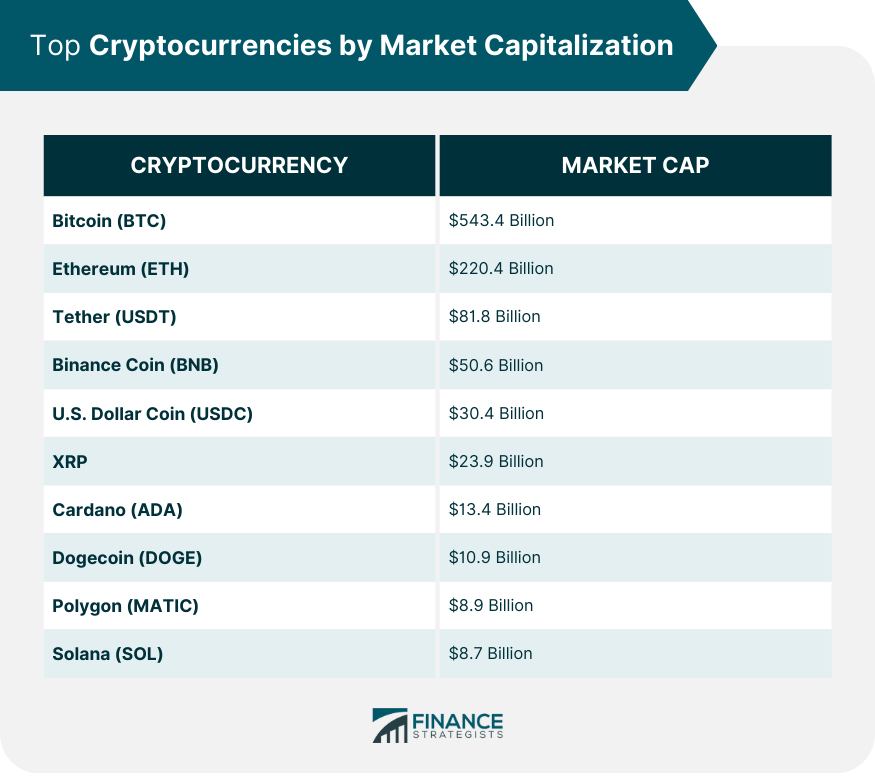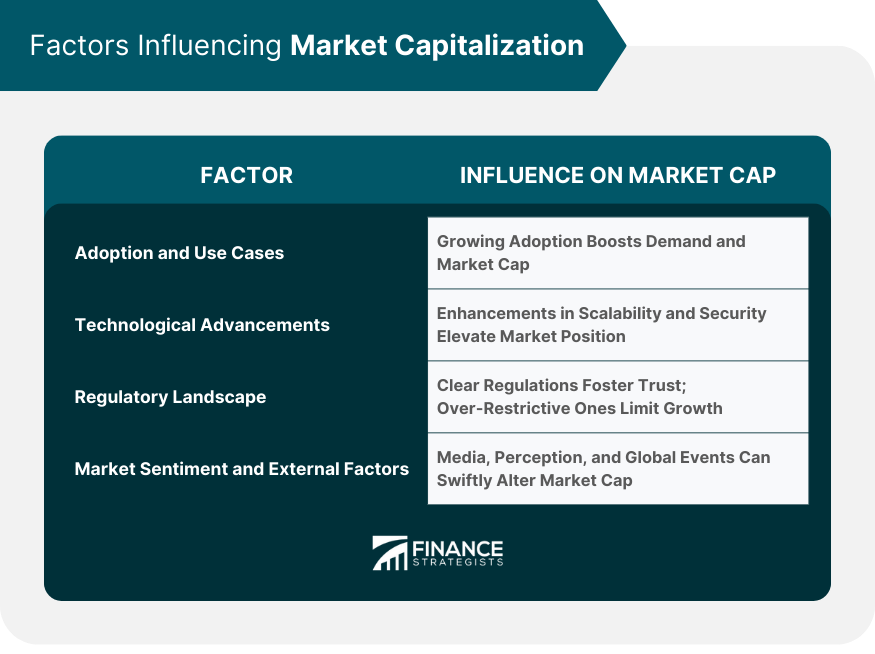Cryptocurrencies represent a groundbreaking form of digital money, operating outside traditional banking parameters. These digital assets offer multiple advantages, such as decentralization and increased security via cryptography. Market capitalization, often termed 'market cap', quantifies the total value of a cryptocurrency by multiplying its current price with the total circulating tokens. It serves as a direct reflection of a cryptocurrency's market position, showcasing its relative weight and influence in the vast digital economy. Market capitalization is pivotal when evaluating a cryptocurrency's worth and market standing. A formidable market cap not only signifies a coin's substantial presence but also its acceptance and the trust investors bestow upon its potential. Furthermore, it aids in comparing the stature of various cryptocurrencies, providing insights into market dynamics and investor sentiments. Additionally, it acts as a gauge to measure the relative risks associated with each digital asset. As the first cryptocurrency, Bitcoin carved the path for a myriad of digital assets. With its market cap of $543.4 billion, its dominance is unquestionable, mirroring its widespread acceptance and pioneering status. The decentralized nature of Bitcoin has challenged traditional financial systems, promoting a more inclusive financial ecosystem. Its resilience over a decade, despite market fluctuations, cements its position as a significant financial instrument. Beyond being a cryptocurrency, Ethereum has introduced the world to smart contracts and decentralized applications. With its market cap reflecting $220.4 billion, Ethereum's importance goes beyond its monetary value. The Ethereum platform has given rise to numerous decentralized finance (DeFi) projects and tokens, diversifying the crypto landscape. Its open-source nature continues to drive innovation and collaboration within the community. Tether's distinction lies in its stable value, pegged to the US dollar. With a robust market cap of $81.8 billion, Tether is a preferred choice for traders seeking a stable asset in the volatile crypto realm. Its use as a hedge against crypto volatility showcases the multifaceted roles cryptocurrencies can play. Tether also aids in capital preservation during market downturns, offering a reprieve from potential losses. Originally introduced for the Binance exchange, BNB, valued at $50.6 billion in market cap, has evolved over time. Today, it plays numerous roles, from facilitating reduced transaction fees on Binance to being used in various DeFi projects. BNB's versatility showcases the adaptability of cryptocurrencies to cater to diverse market needs. Furthermore, the Binance Smart Chain platform is fostering a new generation of digital projects, further elevating BNB's importance. USDC, another formidable stablecoin, mirrors the value of the US dollar. Its substantial market cap of $30.4 billion signifies its pivotal role in the crypto ecosystem. Acting as a bridge between the traditional and digital financial realms, USDC facilitates smoother, faster transactions. Its transparency and regular audits have helped it earn trust, making it a preferred choice for many traders. Valued at $23.9 billion in market cap, XRP stands apart with its focus on facilitating global money transfers. XRP promises reduced transfer fees and faster transaction times compared to traditional banking systems. The XRP ledger employs a unique consensus mechanism, making it energy-efficient and environmentally friendly. Its collaboration with various financial institutions further underscores its mission to revolutionize cross-border transactions. Cardano, boasting a market cap of $13.4 billion, represents a research-driven approach to blockchain technology. It has been methodically designed with a focus on sustainability, scalability, and transparency. The Ouroboros proof-of-stake algorithm used by Cardano is a testament to its emphasis on energy efficiency. Its layered architecture allows for flexibility, catering to both financial transactions and smart contract execution. Dogecoin, beginning as an internet meme, has transformed into a cryptocurrency with a market cap of $10.9 billion. Its vibrant community and internet-driven popularity have given rise to several fundraising events and charitable causes. The lighthearted nature of Dogecoin serves as an entry point for many newcomers to the crypto world, introducing them to the nuances of digital assets. Its consistent presence in popular culture keeps it in the spotlight, ensuring continuous discussions around its value and potential. Polygon addresses Ethereum's scalability issues, offering an enhanced user experience. Its market cap of $8.9 billion reflects its growing significance in the Ethereum ecosystem. Polygon's commitment to ensuring a seamless, low-fee transaction environment has made it popular among developers. With Ethereum 2.0 on the horizon, Polygon's role in providing interim scalability solutions further magnifies its relevance. Solana's unique architecture allows it to process transactions at lightning speed. Its market cap of $8.7 billion symbolizes its emerging role as a high-performance blockchain platform. Solana's emphasis on scalability without compromising security has garnered attention from developers and investors alike. The influx of decentralized projects being built on Solana stands a testament to its robustness and potential. Utility is the bedrock of a cryptocurrency's value. While speculative value plays a role, the sustained success of a digital asset depends largely on its functional worth. Be it transaction speed, enhanced security features, or tangible real-world applications, utility encompasses a coin's practical benefits. The broader the utility spectrum, the more entrenched a cryptocurrency becomes in the global financial fabric. Each leading cryptocurrency brings distinct utilities to the table. Bitcoin, often dubbed "digital gold", offers a store of value. Ethereum's platform facilitates decentralized applications, pushing the boundaries of what blockchain can achieve. Stablecoins cater to those seeking stability in a volatile market, while platforms like Solana and Polygon enhance scalability. Thus, a cryptocurrency's standing often mirrors the breadth and depth of its utility. Utility, despite its significance, remains challenging to quantify. As the crypto landscape is dynamic, what's perceived as beneficial today might lose relevance tomorrow and vice versa. Additionally, the utility's perception varies among users, developers, and investors, leading to diverse valuation metrics. Hence, continuous monitoring and reassessment become imperative to gauge a cryptocurrency's evolving utility accurately. In the ever-evolving world of cryptocurrencies, discerning genuine utility from transient hype is crucial. While some cryptocurrencies experience growth driven by authentic solutions, others might benefit from short-lived popularity or media frenzies. Thorough research, community engagement, and understanding of underlying technologies are paramount for distinguishing between the two and making informed investment decisions. A cryptocurrency's market cap is directly influenced by its adoption rate. As more individuals and institutions engage with a coin—either as a medium of exchange, a platform, or an investment—its demand soars. Successful real-world implementations or use cases can amplify a coin's credibility, bolstering its market cap. The evolution from niche communities to mainstream acceptance can rapidly elevate a coin's market position. In the tech-driven world of cryptocurrencies, innovative advancements can significantly sway a coin's market cap. Features that enhance scalability, security, or overall utility can position a coin favorably in the competitive landscape. As blockchain technology continues to mature, cryptocurrencies that continually adapt and refine their offerings tend to see increased adoption and, consequently, market cap growth. While regulatory clarity can act as a catalyst for institutional adoption, fostering trust and legitimacy, over-restrictive regulations can hinder a cryptocurrency's growth potential. A balanced regulatory framework, which safeguards investors without stifling innovation, can positively impact a cryptocurrency's market cap. However, sudden regulatory shifts can introduce volatility, underscoring the need for proactive engagement with regulators. The intangible element of market sentiment can drastically influence cryptocurrency market caps. Factors like media narratives, public perception, influencer endorsements, and geopolitical events can either bolster or dent market cap, often within short time frames. Therefore, staying abreast of global events and understanding their potential ripple effects on the crypto market becomes essential for investors. Market cap is more than a mere ranking metric. It offers a lens into a cryptocurrency's relative stature in the market, shedding light on its stability and resilience. A higher market cap often signals reduced volatility, providing investors with a semblance of predictability in an otherwise turbulent market. For potential investors, market cap serves as a valuable tool, highlighting a cryptocurrency's relative strength, growth trajectory, and overall market acceptance. It assists in devising investment strategies, allowing investors to balance high-risk, high-reward assets with more stable ones, thus optimizing potential returns. Market cap provides an aggregate value of a cryptocurrency, but liquidity paints a picture of its market fluidity. While a high market cap might indicate a cryptocurrency's significant presence, it doesn't always translate to high liquidity. Liquidity reflects the ease with which an asset can be traded without significantly impacting its price. For investors, understanding the interplay between market cap and liquidity is pivotal, ensuring smoother trade execution and exit strategies. The digital revolution ushered in by cryptocurrencies has reshaped the financial landscape, with market capitalization playing a pivotal role in assessing a crypto's worth and influence. These digital assets, ranging from the pioneering Bitcoin to platforms like Ethereum and emerging contenders like Solana, each contribute uniquely to the decentralized economy. Their utility—whether as a medium of exchange, a platform for decentralized apps, or a hedge against volatility—underpins their value. Yet, understanding a cryptocurrency goes beyond its market cap. Technological advancements, global sentiment, and regulatory frameworks can profoundly impact valuation. As the crypto realm grows, discerning between genuine utility and passing hype is paramount. Furthermore, while market cap showcases a crypto's relative dominance, liquidity highlights its tradeability. Together, these metrics offer a comprehensive lens into the intricate dynamics of the cryptocurrency ecosystem, guiding informed investment and fostering a deeper understanding of digital finance.Overview of Cryptocurrencies and Market Capitalization
Top Cryptocurrencies by Market Capitalization
Bitcoin (BTC)
Market Cap: $543.4 Billion
Ethereum (ETH)
Market Cap: $220.4 billion
Tether (USDT)
Market Cap: $81.8 Billion
Binance Coin (BNB)
Market Cap: $50.6 Billion
U.S. Dollar Coin (USDC)
Market Cap: $30.4 Billion
XRP
Market Cap: $23.9 Billion
Cardano (ADA)
Market Cap: $13.4 Billion
Dogecoin (DOGE)
Market Cap: $10.9 Billion
Polygon (MATIC)
Market Cap: $8.9 Billion
Solana (SOL)
Market Cap: $8.7 Billion

Role of Utility in Cryptocurrency Valuation
Definition and Importance of Utility in Cryptocurrencies
Examples of Utility in Top Cryptocurrencies
Challenges in Quantifying Utility
Utility vs Hype: Navigating the Cryptocurrency Landscape
Factors Influencing Market Capitalization
Adoption and Use Cases
Technological Advancements
Regulatory Landscape
Market Sentiment and External Factors

Significance of Market Cap Beyond Ranking
Evaluating the Relative Size and Stability
Using Market Cap for Investment Decisions
Market Cap vs Liquidity
Bottom Line
Largest Cryptocurrencies by Market Cap FAQs
Market capitalization quantifies the total value of a cryptocurrency by multiplying its price with circulating tokens.
Utility defines a coin's practical benefits, and its breadth directly affects the cryptocurrency's long-term value.
As the pioneer cryptocurrency, Bitcoin's widespread acceptance and resilience have solidified its market cap dominance.
Advancements that enhance scalability, security, or utility can boost a cryptocurrency's adoption and market cap.
While market cap shows a cryptocurrency's value, liquidity reflects its ease of trade without drastically affecting the price.
True Tamplin is a published author, public speaker, CEO of UpDigital, and founder of Finance Strategists.
True is a Certified Educator in Personal Finance (CEPF®), author of The Handy Financial Ratios Guide, a member of the Society for Advancing Business Editing and Writing, contributes to his financial education site, Finance Strategists, and has spoken to various financial communities such as the CFA Institute, as well as university students like his Alma mater, Biola University, where he received a bachelor of science in business and data analytics.
To learn more about True, visit his personal website or view his author profiles on Amazon, Nasdaq and Forbes.











